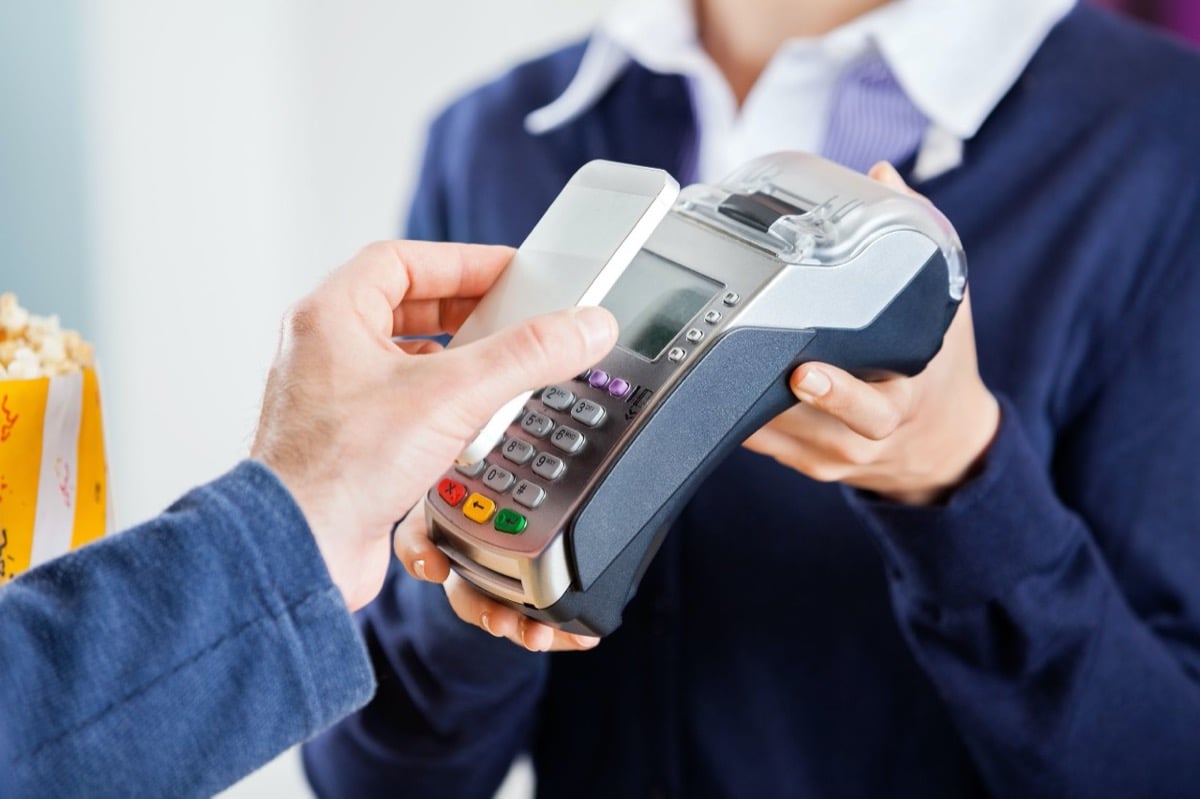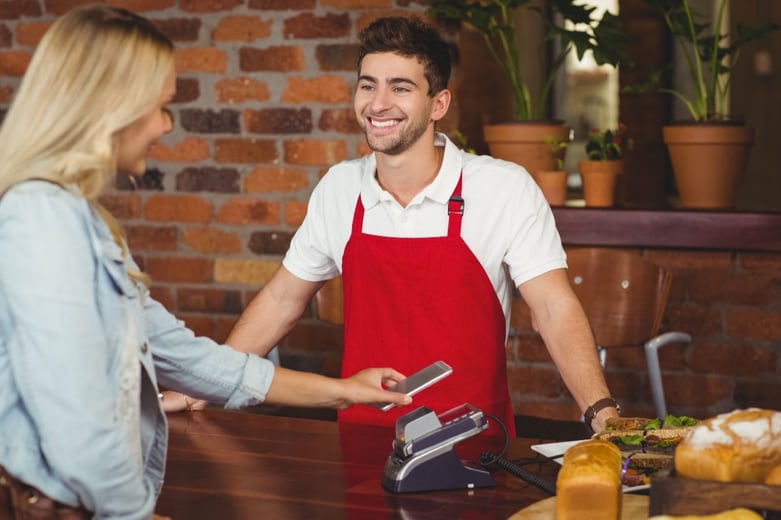
Mobile payments offer a new option for monetary transactions. While mobile payments have not replaced the use of cash, checks and credit or debit cards, the technology is becoming more popular among customers for its convenience.
Mobile payments saw a surge in 2020, as the need to transact business at a distance increased. Mobile payment companies are poised to continue building momentum as a result of this increased interest.
Customer Adoption of Mobile Payments Is Increasing
Mobile payments volume continues to expand as more customers adopt mobile payment options.
Between 2018 and 2019, “mobile payments volume increased 41 percent, from $69.8 billion to $98.8 billion in the U.S.,” writes Pete Reville, director of primary research services at Mercator Advisory Group. By 2023, the total mobile payment transaction value in the country is expected to reach $220.03 billion, writes Amy He at eMarketer.
An overall rise in mobile payments use could be driven in two ways: more customers use mobile payment apps, or those same customers make more payments through mobile platforms. Over the past year, mobile payment growth has largely been driven by new customers using mobile payments for the first time, writes Reville.
Interest in mobile wallets led the most recent surge in mobile payment adoption. During the COVID-19 pandemic, mobile wallets saw a 68 percent increase in use, according to Marqeta’s 2020 State of Payments Report. Users cited convenience and health reasons for the switch, and 90 percent said they expected to keep using their mobile wallets even after the pandemic ends.
While younger customers are adopting mobile payments, the recent increase in mobile wallet use was largely driven by older generations. Marqeta’s study found that 80 percent of respondents ages 35-50 used mobile wallets in 2020; only 67 percent of respondents ages 26- 34 did.
Speed and convenience drive customer interest in mobile payments. A 2019 report by Speedpay found that more than 50 percent of consumers say they would “consider using a mobile wallet to pay bills in the future” because of the speed and convenience offered through that payment method.

Mobile Payment Companies Are Prioritizing Simplicity
Convincing reluctant customers to adopt mobile payments is not only a matter of speed and convenience but also of demonstrating the ability to meet a customer’s need more effectively than familiar options like cash or card.
For many customers, early mobile payment options weren’t any more convenient than using cash or a card. Reaching for their phone to pay was no harder or easier than reaching for their wallet. Because customers associated it with checkouts from long habit, the wallet won.
Perceived usefulness also has a measurable impact on customers’ willingness to adopt mobile payment technologies. In a 2020 study published in the International Journal of Bank Marketing, researchers Carlos Flavian, Miguel Guinaliu and Yuntao Liu write that “when users come to recognize the usefulness of mobile payment over other payment methods (such as cash and credit cards), for example, through completing their transactions more conveniently, they will tend to adopt mobile payment over these other methods.”
Flavian, Guinaliu and Liu suggest that customer mindfulness also plays a key role in the adoption of mobile payments technologies. By helping customers become aware of their options in the present moment, then, mobile payment companies may help them choose mobile payments over more conventional means.
To change customers’ longstanding habits, mobile payments technology has benefited from expansion into a wide range of settings. When customers have the option to pay at a grocery store or restaurant with mobile payment options like a mobile wallet, they have the opportunity to use their smartphone rather than card or cash. The more times the customer chooses a mobile payment option, the more they become familiar with doing so.
Mobile wallets use near field communication technology or QR codes to prompt an online bank transfer. Top mobile wallet apps in this space include Apple Pay, Google Wallet, WeChat Pay and AliPay, writes Alex Rolfe at PCM. When a place of business has the appropriate technology in place, customers can pay with their smartphones or watches instead of with a card, check or cash.
Some habits are harder to change than others, however. A PYMNTS.com survey found that even during the early months of the COVID-19 pandemic, only 5.1 percent of shoppers reported using Apple Pay to check out at a local grocery store or other point of sale (POS) terminal. Although 93 percent of all smartphones in the U.S. can run Apple Pay, 95 percent of customers don’t use the app or any other mobile wallet to make in-store purchases, according to the survey.
Instead, the rise in mobile payments during COVID-19 has been driven by factors other than POS sales.
These include a sharp increase in online shopping, which has boosted not only the use of mobile wallets but also of other mobile and electronic payment options, like PayPal. Digital payment services like PayPal and Venmo also gave many Americans a way to receive their stimulus checks via direct deposit without having to go through or open a traditional bank account. Donations for social causes and movements like Black Lives Matter also drove interest in mobile payment options, writes Richard Yao, manager of strategy and content at IPG Media Lab.

Contactless Payments Are Increasingly Popular
Despite customers’ slower adoption of mobile wallets for in-store purchases, contactless payment options are gaining popularity.
Contactless payments stepped into the limelight during the COVID-19 pandemic because they offered a way to create one less touchpoint that could transmit a virus. Their popularity, however, indicates that contactless payments will survive long after COVID-19 is controlled.
In one survey by Mastercard, 82 percent of respondents said they saw contactless payments as cleaner than handing over cash or swiping a card. Because contactless payments are often faster, customers were also able to spend less time standing in checkout lines — another site of potential exposure to the coronavirus.
“Contactless offers consumers a safer, cleaner way to pay, speed at checkout, and more control over physical proximity at this critical time,” says Blake Rosenthal, executive vice president and head of Mastercard Acceptance Solutions.
Post-pandemic, contactless shopping is likely to remain popular due to its speed and its added layer of protection from other viruses and bacteria that may be transmitted through touch, such as the common cold.
“If you’re at a grocery store or a drug store where a consumer should avoid touching a terminal or coming into contact with the cashier, what contactless products really provide is an avenue to shop safely,” says Linda Kirkpatrick, president of U.S. issuers at Mastercard.
Mobile payment options have established a promising presence in the constellation of customer payment options. But this technology still has much room for growth in the U.S. market.
“While mobile payments are growing ($98.8 billion in 2019), they are still only a fraction of the trillions spent on credit and debit cards by consumers in the U.S. There is still a lot more growing to do,” writes Reville. Companies that turn to mobile payment options today position themselves to embrace that growth.
Images by: Tyler Olson/©123RF.com, Shao-Chun Wang/©123RF.com, Wavebreak Media Ltd/©123RF.com
